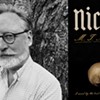Published November 8, 2006 at 2:11 p.m.
Many people's last memories of their loved ones are also the most lasting. Events that occur in the final days leading up to the death of a friend or family member can be a graceful coda on a well-lived life - or an aching wound that never fully heals. When Stephen Kiernan reflects on his parents' last days, he sees opposite ends of a spectrum ranging from "tragedy in slow motion" to "a beautiful death."
Kiernan, 46, is a Charlotte author and former reporter and columnist for The Burlington Free Press. His first lesson in mortality began with the illness that claimed his father's life. Felled by an aneurism in August 1988, Peter Kiernan spent 28 days in an intensive-care unit undergoing increasingly invasive, costly and ultimately futile medical care. Attached to a breathing tube, his eyes bloodshot and swollen, lips cracked and bleeding and body bloated with fluids, Peter Kiernan was stripped of the dignity that had defined his character. Ultimately, the quarter-million dollars' worth of medical interventions inflicted on him were all for naught, as they couldn't save his life or provide him or his family with a shred of lasting comfort.
Four years later, when Kiernan's mother was diagnosed with small-cell breast cancer, the family would not repeat the same mistakes. Rather than subject herself to the excruciating pain of a hugely disfiguring surgery, Mary Agnes Kiernan chose to die the way she had lived - with the stubborn determination of a woman who did things her way, or not at all. She completed all her chosen tasks before she succumbed, from finishing her Christmas shopping four months early to planning her son's wedding. In the end, she died in her own bed, with her pain properly managed and her family by her side. Looking back, Kiernan recalls that nothing was left unsaid or undone and, in his words, "her bright character had remained undimmed."
About 2.5 million Americans die each year - about 6850 per day. But as Kiernan discovered while researching his first book, Last Rights: Rescuing the End of Life From the Medical System, only a small fraction of them depart this earth in a way that's dignified, rewarding or even comfortable.
Instead, Kiernan found that his father's death experience was far more typical among Ameri- cans than that of his mother. Too often, people die in the cold and impersonal environs of hospitals and nursing homes, attached to respirators and feeding tubes, often without family or friends nearby. Unlike what most Americans say they want or envision for themselves, the dying are often subjected to expensive, dehumanizing and extraneous medical procedures that may boost their vital signs over the short term but do little or nothing to relieve their suffering. The consequences for patients and their families can be devastating, both personally and financially. Not surprisingly, the leading cause of personal bankruptcies today are medical expenses, even among the insured.
What's worse, about half the people who die in hospitals do so in moderate to severe pain that could have been alleviated, if only their doctors and other caregivers had been adequately trained in palliative care and proper pain management - and cared enough to offer them. Kiernan argues that when the terminally ill are caught in the grips of blinding pain, their one last opportunity to find reconciliation, spiritual meaning and closure with their loved ones can be lost forever.
"Here is the fundamental problem in the quality of end-of-life care in America," Kiernan writes in Last Rights. "The people we rely on to provide this help do not know how to do it . . . At virtually every level - clinical, practical, spiritual - they are unprepared."
Kiernan compares the way most Americans die today to the situation 30 years ago. In the 1970s, people typically lost their lives suddenly and traumatically by car accidents, heart attacks and strokes. Today, more Americans meet their maker as a result of the slow, gradual decay of Alzheimer's, cancer, AIDS or chronic respiratory disease.
These changes, which have resulted in longer life expectancies, have been made possible through a number of remarkable medical advances and technological breakthrough - from beta-blockers for heart problems to safer automobiles to the near-ubiquity of the 9-1-1 emergency-response system. At the same time, Kiernan argues, the medical system has failed to adapt to this changing landscape and recognize its responsibility not only to heal but to comfort.
As Kiernan explains in a recent interview with Seven Days, this mindset begins with the education of doctors and nurses. A typical American medical student cannot graduate without at least 300 hours of obstetrics training, even though few of these students will ever deliver a baby in the course of their careers. In contrast, the average med student receives only 24 hours of training in end-of-life care. Kiernan found only six medical schools in the nation that require a course in pain management. Medical educators, he says, "spend more time teaching students how to deliver a baby than how to deliver an adult into eternity" - a tragic state of affairs, considering that only one of these conditions will affect 100 percent of their patients.
Compounding the problem, Kiernan notes, are various public policies that discourage doctors from recommending hospice care for their terminally ill patients. Decades of evidence show that hospices are vastly superior to hospitals and nursing homes for managing pain, meeting families' emotional and physical needs, controlling costs and providing desirable settings for death. Nevertheless, Medicare eligibility rules essentially require patients to give up on seeking a cure before they choose hospice - and they require doctors to give patients a prognosis of less than six months to live, lest they run the risk of being sued for Medicare fraud.
In all, Last Rights paints a distressing picture of the state of dying in America - from physicians' woeful inability to communicate honestly and compassionately with their patients and family members about end-of-life choices; to the often criminally negligent state of the nursing-home industry; to the legal and public-policy deficiencies that leave critical decision-making in the hands of those who are least competent to make them.
Last Rights is written in a style that combines an investigative reporter's dogged attention to detail with the compelling storytelling of a novelist and magazine writer. For this book, Kiernan conducted more than 500 interviews with doctors, nurses, educators, hospice workers and family members. These conversations are interspersed with heartwrenching, touching and even humorous stories about people's final days. The material floats effortlessly between harsh critiques of health-care policies to fascinating accounts of death's many mysteries, without ever becoming either wonky and dense or flaky and maudlin.
Despite its grave subject matter, Last Rights is not a depressing read - far from it. Both in his prose and in person, Kiernan speaks passionately and optimistically about the "opportunities" now before us to rediscover the "art of dying," which can make our passing a rewarding, meaningful and yes, even beautiful event.
*******
Kiernan insists he didn't set out to become an advocate for dying well when he wrote this book, though clearly he's fallen into that role; he now travels around the region giving public talks on end-of-life issues. And, while Last Rights was written from a national perspective, Kiernan has also turned his gaze on Vermont's current state of dying - and he doesn't like everything he sees.
"Vermont is a pretty good place to die," he comments. "But it's not Missoula [Montana], it's not Tampa [Florida], and it's not Madison [Wisconsin]. Those are all much better places to die."
What do these seemingly unrelated cities have in common? Kiernan calls them "islands of excellence" for end-of-life care, where demographics (Tampa), funding (Madison) or charismatic leaders (Missoula) have effected significant changes in how people die.
"Right now as a society, we're willing to accept islands of excellence in end-of-life care," Kiernan adds. "But we wouldn't accept islands of excellence at delivering babies, or at setting broken limbs, or giving stitches, or getting a heart attack dealt with."
Things in Vermont have improved somewhat since Kiernan began researching Last Rights. For instance, in mid-2005 Vermont strengthened its laws on advance directives, which enable citizens to decide beforehand the level of medical intervention they wish to receive at the end of their lives. Additionally, Kiernan notes, Vermonters now have more rights to learn about the professional track record of their physicians.
That said, Vermont still has a way to go before it can be considered an island of excellence, too. For one, Kiernan suggests the state make advance directives legally binding public documents, so that EMTs responding to an emergency could quickly ascertain how much medical intervention to provide or withhold.
Second, Kiernan would like to see Vermont driver's licenses include a box to indicate the person has an advance directive. Third, he believes that if the University of Vermont's College of Medicine were to "quintuple" its pain-education curriculum, it still wouldn't be too much. As he puts it, no area of the medical field overemphasizes pain management, especially in light of the remarkable advances in painkilling drugs.
Hospitals and nursing homes in Vermont should put a premium on pain management and palliative care, he suggests, and even issue annual report cards on the quality of their end-of-life performance, such as their adherence to advance directives. Imagine how Vermont medical facilities would become magnets for patients if they promoted themselves as leaders in this field, Kiernan says, especially as growing numbers of baby boomers confront the inevitable reality.
Ultimately, this isn't about doing death "on the cheap," Kiernan emphasizes, though from all evidence, good end-of-life care is both cost-effective and more rewarding for families. It's about making death dignified and meaningful again. To do so, he says, we as a nation must find the "metaphysical maturity" to recognize that how we die is as important as how we live. Because, unlike other choices we make in life, we only get one shot at doing it right.
More By This Author
Speaking of...
-

Sitting Vermont Sen. Dick Sears Has Died
Jun 2, 2024 -

Longtime Vermont Senator Richard 'Dick' Mazza Dies
May 27, 2024 -

On the Beat: New Music From Freya Yost and Kristina Stykos, Radio Bean Temporarily Closes After Fire
May 8, 2024 -

Soundbites: Waking Windows Returns
May 1, 2024 -

Waking Windows Announces 2024 Lineup
Apr 12, 2024 - More »
Comments
Comments are closed.
From 2014-2020, Seven Days allowed readers to comment on all stories posted on our website. While we've appreciated the suggestions and insights, right now Seven Days is prioritizing our core mission — producing high-quality, responsible local journalism — over moderating online debates between readers.
To criticize, correct or praise our reporting, please send us a letter to the editor or send us a tip. We’ll check it out and report the results.
Online comments may return when we have better tech tools for managing them. Thanks for reading.











































